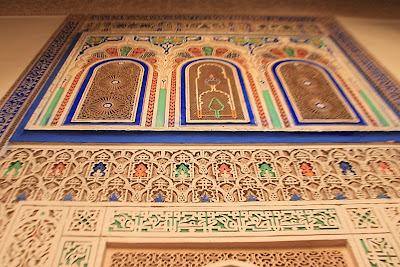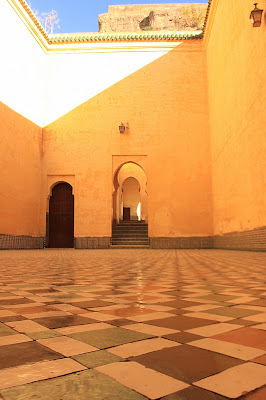For those interested in History and remains of the past, Morocco is undoubtedly one of the greatest places on Earth to explore. Aside from the Medinas that showcase a life trapped in a time warp, and the crumbling ruins of the Valley of a Thousand Kasbahs, there is evidence of life long since passed in every small village or town you go to. Ramparts that would be walled and protected elsewhere are used as a place to secure animals or park a car. People here have a great deal of respect for the past, but this respect is doused with practicality. Why cordon off a strip of 10th Century wall when it could be used to build a new home against, after all, it’s only a wall.
While in Meknes and Fes you see stretches of these imposing walls. Up to 15 metres in height the one in Meknes winds around the city for 25 kilometres. Understandably crumbling in places, this wall was commissioned by the 17th Century ruler Moulay Ismail after he took over control of the weakened country from his brother who was killed when he fell off a horse in 1672. Sadly Moulay Ismail was so busy building walls and seeing off the competition for right of rule from his 83 brothers and half-brothers, that he was unable to finish building what would have been one of the greatest palaces in the country. Murdering those who failed to submit to his rule, family or otherwise, Moulay Ismail who was also known as Warrior King was one of the greatest leaders of the era. Famous for doing gruesome things such as adorning his new wall with the heads of slain enemies he also managed to build up 160,000 strong elite army called the ‘Black Guard’. This fearsome army successfully subdued the rest of the Moroccan feuding tribes, get rid of most of the Spanish and Brits from the country, and prevent further invasion. This army grew from 16,000 slaves that Moulay Ismail brought from sub Saharan Africa. By providing them with women he bought not only their allegiance but also their children who grew to become soldiers.
As well as all the wall building, murder, fighting and organising, Moulay Ismail fathered literally hundreds of children (876 if you believe Wiki). This caused chaos when he died as it took years to resolve the small issue of who was to be his successor.
Visiting Moulay Ismail’s Mausoleum, it takes a moment for it to register that not only is there no entrance booth; there are also no pestering guides, no information pamphlet or even a single sign. Set into one of his majestic and ornate walls the tomb is reached by walking through five connected courtyards. Contrary to guide book predictions during our visit we didn’t have to squeeze past busloads of tourists and had the place more or less to ourselves. Blue sky contrasts with the tall yellow walls and colourful mosaics. Fountains add to the sense of peace. The aim of the courtyards and fountains being to humble and calm all visitors before they reach the tomb of Moulay Ismail. The simplicity of the first four courtyards contrast greatly with the fifth area and the tomb itself. Foreigners are not allowed to approach the tomb and have to stop in the fifth area. This is possibly the most spectacular space anyway, with light pouring through high windows onto some of the finest craftsmanship that Morocco has to offer. Years’ worth of carving, engraving and mosaic laying has survived through the ages.
As beautiful as the interior is, it is the external courtyards which leave a lasting impression. The fountains, calls of the birds high on the walls and gentle sweeping of the old man in charge of keeping the place tidy, all combine to make it a very serene escape from the harsh light and honking cars outside.














No comments:
Post a Comment